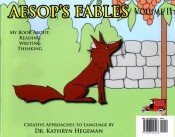These four delightful workbooks offer an approach to language arts for children that is more child-friendly than most workbooks. Each book combines coloring, drawing, critical thinking, character building, and formation of values, with reading skills, composition, grammar, and other language arts skills such as sequencing, alphabetizing, dictionary usage, listening, and public speaking.
The four 48-page workbooks are intended to be used as a set for one school year, although you might stretch them out over a few years. The relatively small size of each book makes them very unintimidating in contrast to the 232-page book you would have if all four were bound into a single book. There are twelve, multi-part lessons per book, so you will probably complete a little more than one lesson per week if you are completing them all in one year.
Each lesson has four pages. The first page has the fable, the moral of the story, and a list of “Words to know.” The second page has a blackline illustration of the story with space for children to write a sentence about the picture. Children may color this picture.
The third and fourth pages vary from lesson to lesson to cover a broad range of skills. Some pages include instructional information. For example, page 42 in Volume 1 teaches about paragraphs, including their construction and indentation.
Most pages are illustrated in some way. Even traditional type activities such as identifying the nouns or verbs in a story have children write their answers into an illustration. Children are frequently asked to draw, sometimes to show what they think might happen next or another form of creative thinking. Problem-solving and critical thinking are taught throughout the series. Every lesson includes a “Something to think about” question that generally (but not always) relates to the moral of the lesson’s fable. For example, the moral of the fable of “Mercury and the Woodman” is “Honesty is the best policy.” The question posed is “Why is it important to be honest?” While these questions should probably be answered orally, children will write sentences, words, and paragraphs in the workbooks for other language arts activities.
Children learn basic composition and grammar skills including parts of speech (nouns, verbs, adjectives, adverbs, and prepositions), punctuation, capitalization, contractions, apostrophes, synonyms, antonyms, rhymes, and poetry. Work on reading comprehension occurs as children write a sentence about the picture. (If a child has trouble coming up with a sentence, try having them narrate the story back to you. This process should help them come up with something to write.)
I think this Aesop’s Fables series is ideal for children in second or third grade, but it might be used with children a year or two beyond that who need a gentler form of instruction or remediation. The reading level of these lessons ranges from level 2.1 (beginning second grade) in the first book to 4.3 (early fourth grade) in the fourth. Children should be able to read the stories themselves since they will work with story content for some of the language arts activities, so don’t push a second or third grader through these books if the reading is too difficult. Like many resources published by Royal Fireworks Press, this series might be especially useful for gifted learners.
Books are consumable, and they are surprisingly inexpensive. There are no teacher guides or answer keys since instructions are included within the lessons and answers should be easy for parents to figure out.









